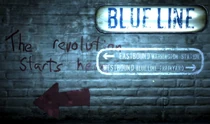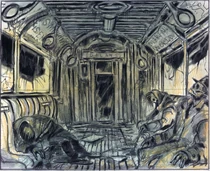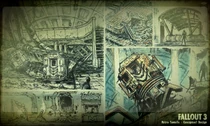|
Reinigung (Problem: Bitte hilf uns, diesen Artikel nach und nach zu übersetzen)
Um den Qualitätsstandards des Fallout Wikis zu entsprechen, braucht dieser Artikel Reinigung. Helfen Sie bitte, den Artikel zu verbessern.
|
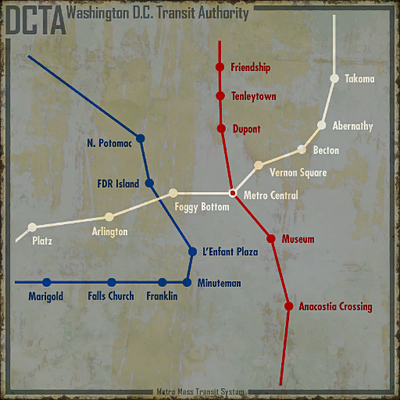
Karte der U-Bahn von D.C., gesehen an der Metro Central U-Bahn Station
“ D.C.'s schnellste Autobahn... ist unten! ” |
Die Metro ist das Nahverkehrs-System, das Washington, D.C. und benachbarte Gemeinschaften in Maryland und Virginia verband. Die Metro wurde von der "District of Columbia Transit Authority" geleitet.
Im Jahre 2277, können die Tunnel zum Vorankommen ziwschen den verschiedenen Zonen und Siedlungen genutzt werden. Doch auch Supermutanten, Ghule und Raider haben es sich in den Tunnelsystemen eingerichtet.
Geschichte und Hintergrund[]
Nach jahrelangem Betrieb wurde die Metro in der Hälfte des 21. Jahrhunderts mit der Hilfe von Vault-Tec und RobCo Industries modernisiert. Sie wurde mit langlebigen Materialien, verbesserter Beleuchtung sowie modernen Sicherheitsanlagen konstruiert. Während der Bauarbeiten wurden dem Streckennetz drei neue Linien hinzugefügt: Die Blaue, Rote und Weiße Linie. Die neuen Linien wurden auf den bereits existierenden Stationen aufgebaut und neue Stationen wurden dem Netzwerk zur Erweiterung hinzugefügt. Der Anstoß zur Erweiterung beruhte auf den sich häufenden Staus und den resultierenden Umweltbelastungen der Autobesitzer.
Im Großen Krieg im Jahre 2077 wurden viele Stationen entweder vollständig oder teilweise zerstört. Viele Überlebende suchten in den Stationen Zuflucht.
In den nächsten beiden Jahrhunderten starben die ursprünglichen Überlebenden unter der andauerden Strahlenbelastung, oder sie Mutierten zu den Ghulen. Andere Gruppen von Überlebenden, die Supermutanten und die Raider, Enterten die Metro um nach neuen Standorten für ihre Basen zu suchen. Von diesen Basen wollten sie von Anfang an nur Angriffe auf Karawanen, Händler oder andere zufällig Vorbeikommende starten. Einige Gruppen, so zum Beispiel die Raider, bildeten kleine Siedlungen zum Überleben in der Metro. Gelegentlich liefern sich die Raider mit den Ghulen Kämpfe, aus denen die Ghule meist als Sieger hervorgehen.
Metro-Züge[]
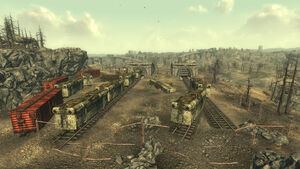
Verfallene Metro-Züge in derMetrostation Meresti.
Die Züge wurden mit der Modernisierung der Metro eingeführt. Jeder Wagen ist ein unabhängiger Teil mit einem Passagier-Teil, der mit einer Kupplung an einen weiteren Wagen gekoppelt werden kann. Ein besonders gebauter Wagen, der Zugwagen, hatte über dem normalen Passagier-Teil einen Teil für den Fahrer. Die Züge konnten mindestens vier Wagen ziehen.
Most of the cars, save for the engine cars, survived the war. The engine cars were either destroyed completely, or salvaged by later visitors to the Metro. It's possible that the engine cars were buried in the tunnel collapses. The appearance of engine cars is preserved in advertisements created for the Metro.
The Metro is unlike many real-world subway systems. The use of an 'engine car' towing unpowered cars is very unusual, most real world versions were phased out as the size of engine motors decreased (An example of such an engine used on the London Underground still exists). Real subways tend to use multiple unit trains where two or more cars are permanently joined, and then assembled into longer trains. Each group of cars has a drivers' cab at each end, removing the need to detach the engine at the end of the line, turn it around and reconnect it to the front of the train for the return journey
While a real subway carries its own engines under each car, it is usually not self-propelled, and instead collects electricity via a third rail or pantograph and overhead wires. The propulsion system in 2277 is an overhead third rail, as seen in the quest Who Dares Wins, wherein a skeleton on a ladder is being electrocuted by a third rail.
Metro-Stationen[]
Stations are identified on the surface level by directional signs and obelisks with the Metro symbol. The main stations have a grander entrance, with four escalators leading down to the station entrance. Smaller stations have single concrete staircases that lead down to the entrance underneath a curved roof of glass panels, now broken. Double chainlink gates open connect the entrance to the station's lobby.
Generally, the stations share a similar configuration. They have a lobby where the customers once bought tickets from a Metro employee ("agent") in a ticket booth. Restrooms and offices are located off the lobbies. Some lobbies have vending machines. In a few lobbies, there are status displays which show the power status of stations on the three primary lines in Washington, D.C.. There is no display for the surrounding communities.
Customers would walk down a sloping hallway into the mezzanine. In the mezzanine, customers would present their tickets to turnstiles. (Some customers might prefer presenting their tickets to the protectrons that patrolled the lobby.) On the mezzanines, and lower down on the platforms, the customers could rest on benches.
On the platforms, accessible by escalators, customers waited for their trains. Station identifying signs are posted on either side of the platforms. Some stations are known by more than one name. For example, one station is known both as Anacostia Crossing Station and Eastern Market. Further down, in the subway tunnels, signs identified the line.
Metro-Linien[]
By 2077, the Red Line, Blue Line, and White Line were the primary lines for the Metro.
The Red Line was the first line completed. This line has a north-south orientation. Stops on this line include Metrostation Meresti, Tenleytown/Friendship Station, Dupont Circle Station, Metro Central, Museum Station, and Anacostia Crossing. The northern terminus for the Red Line is Meresti Trainyard. Somewhere south of the Anacostia River, the Red Line ends in Virginia. At Metro Central, the Red Line and White Line intersect. Customers have the option of purchasing a special ticket, the red pass card, for riding this line. According to a status monitor display, the stations are currently receiving power. The route of this line is featured in an advertisement for the Metro.
The Blue Line was the next line completed. This line begins north-west of Washington, D.C. in Maryland, loops through the city, and ends west of the city in Virginia. Stops on this line include N. Potomac, FDR Island, L'Enfant Plaza, Minuteman, Franklin Station, Falls Church Station, Marigold Station, Jury St. Station, and Warrington Station. The Virginia terminus is at Warrington Trainyard. Like the Red Line, customers can purchase a special ticket, the Blue Pass Card, for riding this line. With the exception of a few stations, according to the status monitor display, most stations on this line in the city are currently powered. This line doesn't intersect with the Red or White Lines.
The White Line was the last line completed. This line begins north-east of Washington, D.C. in Maryland, passes through the heart of the city, and ends south-west of the city in Virginia. Stops on this line include Takoma, Abernathy, Becton, Vernon Square, Metro Central, Foggy Bottom, Arlington, and Platz. Unlike the other two lines, no special ticket was ever released for this line. This may be that the Great War intervened before a White Pass Card was available for purchase. White Line intersects the Red Line at Metro Central. According to the status display monitor, all stations in the city on this line are receiving power.
There are many stations in the Ödland der Hauptstadt whose connection to these three lines is not fully understood. This is due to the extensive damage that is visited upon these stations. These stations include the Fairfax Metro Station and Bethesda Underworks. Other stations had their entrances so completely destroyed that any attempt at locating them is impossible.
Metro-Protektrons[]
Protectrons are added to the Metro in the modernization program. They are programmed for defending the Metro from a variety of threats. These machines are usually located in a security office off the station lobby. The Lone Wanderer can activate the robot by hacking into a control terminal. Once the protectron is activated, it will head out to patrol the lobby and attack any target (including the player) that does not have a valid metro ticket.
Fortunately, a ticket can normally be found by searching the desks in the offices. Or the player can just blast the Protectron after activating it and loot its energy cell.
Spatial Orientation Issues[]
The Pip-Boy World Map usually indicates where Metro Stations are with a circled-M logo. When you move the pointer to one, it shows the name of the station. The problem is that the name it shows is often not the same as the name that appears if you are outside the subway and bring up the Pip-Boy's Local Map for the area, nor the same as the name you get for the exit to that station when you bring up on a Local Map while inside the subway.
Because of all the interconnections between outside paths and inside subway stations, this name inconsistency adds an additional level of difficulty to getting around in an already difficult situation.
To add to the confusion, the distance scale inside a subway is often not the same as outside. For example, in the Southeast area of the map, the distance looks pretty significant between the Seward Square Station (near the Ranger Compound) and the Anacostia Crossing (near Rivet City), but what looks like miles can be traversed in a flash simply by entering the station and walking no more than a couple of hundred feet across the subway platform.
To adjust for this difference, you get an anomaly in that when you get to the Anacostia Crossing gate after leaving Seward Square, the World Map will show that you are still on the edge of Seward Square, but after exiting the gate, it will show you all the way down by at the station by Rivet City.
This effect is not limited to subways. At the back door of the GNR Building, you get a different positioning before and after going through the door.
One of the worst map glitches may be the Dupont Station and Georgetown West metro station markers. On the World Map, the markers overlap with the Dupont Station marker being to the left (West), which makes it seem like the DCTA Tunnel exit down the stairs from Georgetown West, which is all that shows up on the Local Map, but if you fast travel to the Dupont Station marker, you end up in a completely different area/Local Map.
Metro-Verbindungen[]
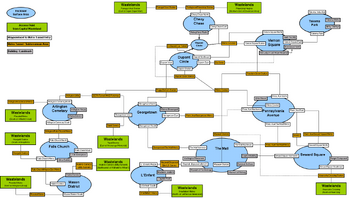
Metro map
While it may appear to be impossible to get very far in the subway tunnels because of all the debris, the fact is that you can get to a remarkable number of locations without ever having to come above ground, and even more when you add in places where you can make short, safe walks above ground from one station's exit to another station's entrance. Note that with just a couple of short above-ground walks, you can get all the way from Farragut West (just across the river from Super-Duper Mart) to Rivet City (near the bottom of the map) and many important places along the way. (For a more detailed guide, click the Discussion tab, above.)
Of course, you are still going to have to fight raiders, Wilde Ghule, and even some Supermutanten, but at least you know you will eventually get where you want to go, and you can pick up a lot of loot along the way. Above ground in the central D.C. area, you are very limited in how far you can go without being blocked by debris.
Vorkommen[]
Die Washington Metro erscheint nur in Fallout 3.
Sonstiges[]
- Viele Metro-Stationen im Ödland der Hauptstadt gibt es auch im echten Washington DC: Tenleytown, Dupont Circle, Foggy Bottom, L'Enfant Plaza, Takoma, Metro Center, West Falls Church, Friendship Heights, Anacostia und Mt.Vernon Sq.
- Andere Stationen im Ödland der Hauptstadt haben eine starke Ähnlichkeit mit echten Pendants wie Marigold: Merrifield, Franklin: Franken und Platz: Wien (beide sind europäische Städte)
- Das echte WMATA-Logo (Washington Metropolitan Area Transit Authority) ist ebenfalls ein M als Großbuchstabe, allerdings in einer anderen Schriftart als in der Fallout-Version.


